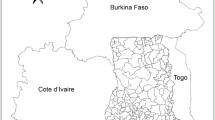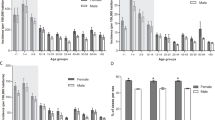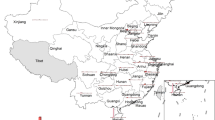Abstract
Intestinal parasites have a serious health problem and frequently infect children in poor urban areas in developing countries. Some types of Cryptosporidium, Entamoeba and Giardia are amongst the most prevalent ones. The aim of this study was explore the distribution pattern of intestinal parasites and the ecological niche of Giardia lamblia in Ardabil Province. This was retrospective cross-sectional study, the officially registered statistics of health centers and hospitals in Ardabil University of Medical Sciences from January 2017 to December 2019 were used. The Kriging interpolation analysis was run to detect the high-risk areas of the disease in the province (P < 0.05) by ArcGIS10.4.1 and to construct the ecological niche model of the G.lamblia parasite, analyzed by Maxent3.3 software. Totally of 238 cases of intestinal parasite were reported during the study period, 77.7% of which were males and 22.3% females. Seven types of intestinal parasites were prevalent with G.lamblia species (79.4%) being the most and Entamoeba histolytica species (4%) the least prevalent one. There was one hotspot in the province in the center with an incidence risk of 41–45.5%. The most important climate and environmental factors affecting the ecological niche of G.lamblia are Bio16, Bio3, and the NDVI. G.lamblia is the most prevalent intestinal parasite in Ardabil Province; moreover, one important hotspots was also detected in the province that can provide useful information regarding the management and control of this parasite.





Similar content being viewed by others
References
Adham D, Moradi-Asl E, Dorosti A, Khaiatzadeh S (2020) Spatial autocorrelation and epidemiological survey of visceral leishmaniasis in an endemic area of Azerbaijan region, the northwest of Iran. PloS one 15(8):e0236414
Alwan, A. (2011). Global status report on noncommunicable diseases 2010: World Health Organization
Babaei Pouya N, Razmjou E (2018) Epidemiology of intestinal parasites among applicants receiving health card of Ardabil City in 2014. J Health 9(1):115–123
Britton E, Hales S, Venugopal K, Baker MG (2010) The impact of climate variability and change on cryptosporidiosis and giardiasis rates in New Zealand. J Water Health 8(3):561–571
Castillo, P., & Vovlas, N. (2007). Pratylenchus (Nematoda: Pratylenchidae): diagnosis, biology, pathogenicity and management: Brill.
Coronato Nunes B, Pavan MG, Jaeger LH, Monteiro KJ, Xavier SC, Monteiro FA, Carvalho-Costa FA (2016) Spatial and molecular epidemiology of Giardia intestinalis deep in the Amazon Brazil. PloS One 11(7):e0158805
Daryani A, Sharif M, Nasrolahei M, Khalilian A, Mohammadi A, Barzegar G (2012) Epidemiological survey of the prevalence of intestinal parasites among schoolchildren in Sari, northern Iran. Trans R Soc Trop Med Hyg 106(8):455–459
G., A. (1990) A survey of the prevalence of intestinalparasites and their transmission factors of in the city of Eslam Shahr [dissertation]. Tehran Univ Med Sci J 2(4):90–95
Gonçalves MML, Barreto MMG, Maldonado A Jr, Maione VR, Rey L, Soares M, d. S. (2005) Fatores sócio-culturais e éticos relacionados com os processos de diagnóstico da esquistossomíase mansônica em área de baixa endemicidade. Cadernos de Saúde Pública 21(1):92–100
Halimi M, Farajzadeh M, Delavari M, Takhtardeshir A, Moradi A (2014) Modelling spatial relationship between climatic conditions and annual parasite incidence of malaria in southern part of Sistan & Balouchistan province of Iran using spatial statistic models. Asian Pac J Trop Dis 4:S167–S172
Hanafi-Bojd AA, Azari-Hamidian S, Hassan V, Zabihollah C (2011) Spatio—temporal distribution of malaria vectors (Diptera: Culicidae) across different climatic zones of Iran. Asian Pac J Trop Med 4(6):498–504
Hazrati Tappeh K, Manafi G, Asgharzadeh M, Manafi F (2014) Incidence of Giardia lamblia subspecies by PCR-RFLP in stool specimens of hospitalized children at Urmia Mutahhari hospital, west azerbaijan Province Iran. Iran J Parasitol 9(4):541–547
Hegazi MA, Patel TA, El-Deek BS (2013) Prevalence and characters of Entamoeba histolytica infection in Saudi infants and children admitted with diarrhea at 2 main hospitals at South Jeddah: a re-emerging serious infection with unusual presentation. Braz J Infect Dis 17(1):32–40
Hemmati N, Razmjou E, Hashemi-Hafshejani S, Motevalian A, Akhlaghi L, Meamar AR (2017) Prevalence and risk factors of human intestinal parasites in Roudehen, Tehran province Iran. Iran J Parasitol 12(3):364
Hijmans RJ, Graham CH (2006) The ability of climate envelope models to predict the effect of climate change on species distributions. Glob Change Biol 12(12):2272–2281
Khamesipour A, Molaei S, Babaei-Pouya N, Moradi-Asl E (2020) Cutaneous leishmaniasis situation and predicting the distribution of Phlebotomus papatasi and P sergenti as Vectors of Leishmaniasis in Ardabil Province Iran. Korean J Parasitol 58(3):229–236
Kuzehkanani AB, Rezaei S, Babaei Z, Niyyati M, Hashemi S, Rezaeian M (2011) Enteric protozoan parasites in rural areas of Bandar-Abbas, southern Iran: comparison of past and present situation. Iran J Pub Health 40(1):80
Lafferty KD, Dobson AP, Kuris AM (2006) Parasites dominate food web links. Proc Nat Acad Sci 103(30):11211–11216
Marchiondo A, Holdsworth P, Fourie L, Rugg D, Hellmann K, Snyder D, Dryden M (2013) World Association for the Advancement of Veterinary Parasitology (WAAVP): guidelines for evaluating the efficacy of parasiticides for the treatment, prevention and control of flea and tick infestations on dogs and cats. Vet Parasitol 194(1):84–97
Miller WA, Lewis DJ, Lennox M, Pereira MG, Tate KW, Conrad PA, Atwill ER (2007) Climate and on-farm risk factors associated with Giardia duodenalis cysts in storm runoff from California coastal dairies. Appl Environ Microbiol 73(21):6972–6979
Molina N, Pezzani B, Ciarmela M, Orden A, Rosa D, Apezteguía M, Minvielle M (2011) Intestinal parasites and genotypes of Giardia intestinalis in school children from Berisso, Argentina. J Infect Dev Ctries 5(07):527–534
Moradi-Asl E, Rassi Y, Hanafi-Bojd AA, Saghafipour A (2019) Spatial distribution and infection rate of leishmaniasis vectors (Diptera: Psychodidae) in Ardabil Province, Northwest of Iran. Asian Pac J Trop Biomed 9(5):181
Niyyati M, Rezaeian M, Zahabion P, Hajarzadeh R, Kia E (2009) A survey on intestinal parasitic infections in patients referred to a hospital in Tehran. Pak J Med Sci 25(1):87–90
Siyadatpanah A, Sharif M, Daryani A, Sarvi S, Kohansal MH, Barzegari S, Gholami S (2018) Spatial distribution of Giardia lamblia infection among general population in Mazandaran Province, north of Iran. J Parasit Dis 42(2):171–176
Wells K, Gibson DI, Clark NJ, Ribas A, Morand S, McCallum HI (2018) Global spread of helminth parasites at the human–domestic animal–wildlife interface. Glob Change Biol 24(7):3254–3265
Zajac AM, Conboy GA (2012) Veterinary clinical parasitology: John Wiley & Sons
Acknowledgment
Thanks to all the colleagues of the health centers of the cities of Ardabil province. This article has been done with the financial support of Ardabil University of Medical Sciences and number (Project No: 2575) and ethics code number IR.ARUMS.REC.1399.004.
Author information
Authors and Affiliations
Corresponding author
Additional information
Publisher's Note
Springer Nature remains neutral with regard to jurisdictional claims in published maps and institutional affiliations.
Rights and permissions
About this article
Cite this article
Mirzanejad-Asl, H., Karimi, A., Babaei pouya, N. et al. Spatio-temporal analysis and determination of the ecological niche model of Giardia Lamblia (Lambl, 1859) in Ardabil province, northwestern Iran. J Parasit Dis 45, 706–714 (2021). https://doi.org/10.1007/s12639-020-01343-0
Received:
Accepted:
Published:
Issue Date:
DOI: https://doi.org/10.1007/s12639-020-01343-0




